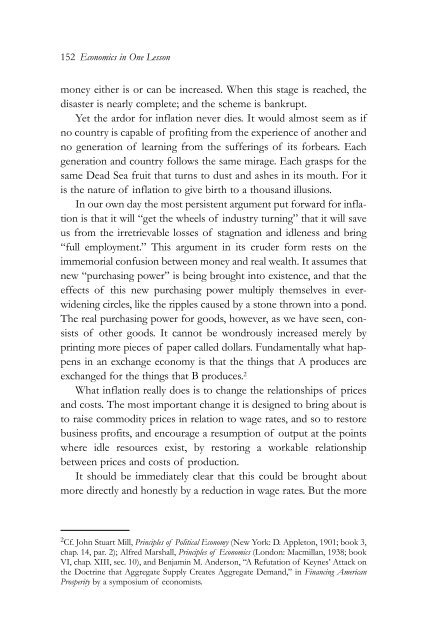1gDdM7w
1gDdM7w
1gDdM7w
- No tags were found...
Create successful ePaper yourself
Turn your PDF publications into a flip-book with our unique Google optimized e-Paper software.
152 Economics in One Lessonmoney either is or can be increased. When this stage is reached, thedisaster is nearly complete; and the scheme is bankrupt.Yet the ardor for inflation never dies. It would almost seem as ifno country is capable of profiting from the experience of another andno generation of learning from the sufferings of its forbears. Eachgeneration and country follows the same mirage. Each grasps for thesame Dead Sea fruit that turns to dust and ashes in its mouth. For itis the nature of inflation to give birth to a thousand illusions.In our own day the most persistent argument put forward for inflationis that it will “get the wheels of industry turning” that it will saveus from the irretrievable losses of stagnation and idleness and bring“full employment.” This argument in its cruder form rests on theimmemorial confusion between money and real wealth. It assumes thatnew “purchasing power” is being brought into existence, and that theeffects of this new purchasing power multiply themselves in everwideningcircles, like the ripples caused by a stone thrown into a pond.The real purchasing power for goods, however, as we have seen, consistsof other goods. It cannot be wondrously increased merely byprinting more pieces of paper called dollars. Fundamentally what happensin an exchange economy is that the things that A produces areexchanged for the things that B produces. 2What inflation really does is to change the relationships of pricesand costs. The most important change it is designed to bring about isto raise commodity prices in relation to wage rates, and so to restorebusiness profits, and encourage a resumption of output at the pointswhere idle resources exist, by restoring a workable relationshipbetween prices and costs of production.It should be immediately clear that this could be brought aboutmore directly and honestly by a reduction in wage rates. But the more2 Cf. John Stuart Mill, Principles of Political Economy (New York: D. Appleton, 1901; book 3,chap. 14, par. 2); Alfred Marshall, Principles of Economics (London: Macmillan, 1938; bookVI, chap. XIII, sec. 10), and Benjamin M. Anderson, “A Refutation of Keynes’ Attack onthe Doctrine that Aggregate Supply Creates Aggregate Demand,” in Financing AmericanProsperity by a symposium of economists.


